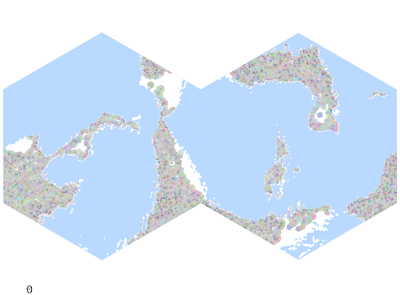It's been a while since I've had much time to devote to my projects. I'm starting to get the itch to actually play again, and the problem rears its head that it's just not done. Nor will ever be done. I've spent a good deal of work on the tribal development system, which would eventually give rise to settled civilizations and more complex societies. I still want to develop that out, but a project of this magnitude is lifelong.
My thought at the moment is to generate a more or less fully populated world, without the benefit of the procedural history system. I would lose a lot of that organic weirdness, like the records of wars and such, but it would significantly shorten the timeline to a version that could be used in an actual game.
Instead of slowly planting and growing cities, I just place them according to the design principles I developed last year: the carrying capacity is determined first by the desirability of the location and then by proximity to nearby cities. This yields between 15,000 and 20,000 cities, ranging in size from villages of 200 to cities of about 75,000 inhabitants.
 |
| Infrastructure map: humans (green), elves (red), dwarves (blue), halflings (orange) |
Not sure why halflings seem to dominate but there is plenty of time for modifying the variables later. This also brings to the front the issue that the world is roughly twice as small as it should be, and is incredibly habitable. Nothing wrong with that, but I do want to rework the map size (which gave me so much trouble 3-4 years ago) to be closer to Earth's surface area.
On the first pass, each city is its own hegemony, leading to a very busy map. About 86% of the habitable surface has at least 1 point of infrastructure, which is almost nothing anyway.
 |
| Hegemony map, very cluttered |
The next step is to collapse these thousands of independent tribes into larger hegemons. Through the sword. This thins out the cities and yields a nicer political map.
 |
| Hegemony map, starting to firm up |
This is approximately 10k hegemonies and about 25k cities. This is more than a pretty good start to create a playable world. I'll tweak this process some more, then begin to add resources and trade networks.

Glad to have you back crunching numbers!
ReplyDeleteWelcome back! It’s good to see an update again!
ReplyDeleteSo how did you come up with this particular map to start with?
ReplyDeleteThe actual terrain? A result of the tectonic simulations, which I'm now reworking.
DeleteYes, thanks!
DeleteYes - also in the interests of 'where to start' given what you know now.
DeleteFor this one I started with hand-drawn tectonics and assigned directions. Then I extracted the directions of the plates to get an "uplift" value where they met, based on the strength of the collision. My new method will be a bit more robust in that it'll be more procedurally generated.
DeleteProcedural is good, definitely, for those of us that don't draw tectonics off the top of their head.
DeleteModelling never finished, but have to use some along the way!
ReplyDelete